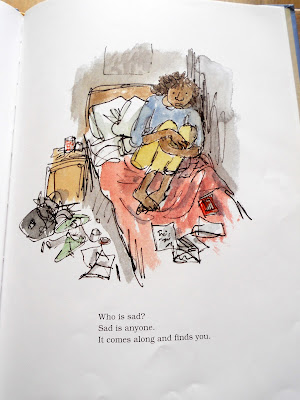A touching, personal story about living and coping with grief
Book Details
Written by Michael Rosen
Illustrated by Quentin Blake
Walker Books 2004
Library Copy reviewed
Back of Book
We all have sad stuff-maybe you have some right now, as you read this. What makes Michael Rosen most sad is thinking about his son Eddie, who died. In this book he writes about his sadness, how it affects him and some of the things he does to try to cope with it. This is a very personal story that speaks to everyone; whether or not you have known what it's like to feel really, deeply sad, its truth will surely touch you.
The Book
This is the poignant story of the author's grief since the death of his son Eddie. In simple, honest words, he explains how he lives with sadness, sometimes hiding it, sometimes feeling overwhelmed by it. He also describes grief for the loss of his mother and general sadness about how his family has changed. While the central theme is grief, this is blended with humour, hope and important messages about coping and managing feelings.
A simply written, beautifully illustrated, touching story.
Why I like this book
As an adult who has experienced grief, I could immediately connect with this beautifully written story.
As a professional who sometimes supports families experiencing bereavement, this book is a valuable resource.
At the time I write this, it has been 11 years since this story was first shared- I have no doubt that since then, it has been a touching read for many children and adults.
In Rosen's personal story, many emotions are expressed including fear, anger, loneliness and acceptance.
Sometimes I want to talk about all this to someone.
Like my mum. But she's not here any more either.
So I can't.
I find someone else. And I tell them about it.
Sometimes I don't want to talk about it.
Not to anyone. No one. No one at all.
I just want to think about it on my own.
Because it's mine. And no one else's.
Rosen shares that, at times he feels sad, not just because his loved ones are gone, but also because his life has been changed forever.
So what happens is that there's a sad place inside me because things aren't the same.
This story uses simple language, prose and metaphors to describe grief and sadness:
It's just a cloud that comes along and covers me up.
Sad is a place
that is deep and dark
like the space
under the bed...
 |
Rosen also admits that there are times when he is downright grumpy. In his honest account he says:
Sometimes because I'm sad I do bad things.
I can't tell you what they are.
They are too bad. And it's not fair on the cat .
And we see the guilty faced Rosen, standing over the startled cat which, he has undoubtedly just kicked.
Later he explains that, he tries to figure out ways of being sad, which don't hurt so much. He chooses to do things that make him feel good (and don't cause other people to feel bad):
 |
| Happy on the outside, sad on the inside... |
What I like most about this book, is that it describes grief and sadness as an ongoing presence in our lives, instead of something we should go through and move on from. As a book which supports the bereaved, it captures grief in realistic terms-we live with it day to day, sometimes it is harder to live with, sometimes we can cope much better.
 |
On reading with a child, at this point, we sometimes discuss the coping strategies used by the author. As the image is quite bleak, for some children it is helpful to be reminded that, writing is something the author chooses to do as a way of coping with sadness. And, while the image conveys sadness and loneliness, maybe Rosen is not lonely here, but is instead choosing to have some quiet time alone with his grief which belongs only to him (as he mentioned in earlier pages.) I often suggest that Michael Rosen's sad feelings are what triggered him to write the book, and as he writes himself on his webpage : 'I hope that it'll be a book that anyone who's been sad about anything at all will help them find out what they're thinking about and why they're thinking it.'
In short
There is no doubt about it, this is indeed a sad book. Simple, honest, heart-breaking and true, it explores sad, angry and lonely feelings.
For a realistic discussion about grief and sad feelings, this book is an ideal resource. I have used this book to support my work with bereaved children & their families and highly recommend it.
Get the book at these affiliate links:
Helpful Resources
I love this great collection of teaching ideas by Mark Warner which can be used along with this book.
If you need further help with childhood bereavement, Barnardos Ireland offer support , information and advice through their Children's Bereavement Service
Here you can download free publications : Coping with Death (for children), Death: Helping Children Understand , Coping with Death (for parents).
KidsHealth.org is another valuable resource I often use . Watch a video of children talking about death here. Read these helpful web pages: When Somebody Dies , Why Am I So Sad?
KidsHealth.Org also provides helpful information for teenagers and parents/carers.



No comments:
Post a Comment